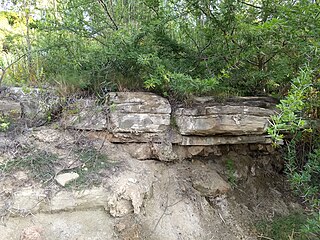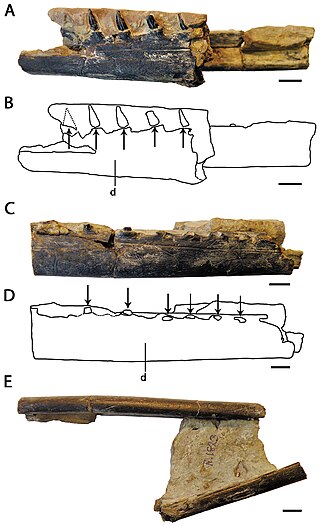Related Research Articles

Bolodon is a genus of extinct mammal from the Lower Cretaceous of Europe and North America. It was a member of the extinct order of Multituberculata and belongs to the suborder Plagiaulacida and family Plagiaulacidae.
Loxaulax is a genus of extinct mammal from the Lower Cretaceous of southern England. It was a member of the also extinct order Multituberculata, and lived alongside the dinosaurs. It lies within the suborder "Plagiaulacida" and family Eobaataridae. The genus Loxaulax was named by Simpson G.G. in 1928 based on one species.
In the geologic timescale, the Valanginian is an age or stage of the Early or Lower Cretaceous. It spans between 139.8 ± 3.0 Ma and 132.6 ± 2.0 Ma. The Valanginian Stage succeeds the Berriasian Stage of the Lower Cretaceous and precedes the Hauterivian Stage of the Lower Cretaceous.

Altispinax is a genus of large predatory theropod dinosaur from the Early Cretaceous period of what is now the Wadhurst Clay Formation of East Sussex, England.

Valdoraptor is a genus of theropod dinosaur from the Early Cretaceous. Its fossils were found in England. It is known only from bones of the feet. The holotype, BMNH R2559, was found near Cuckfield in layers of the Tunbridge Wells Sand Formation dating from the late Valanginian. The specimen is damaged lacking parts of the upper and lower ends. It has a conserved length of 215 millimetres (8.5 in) and an estimated length of 240 millimetres (9.4 in). This genus is paleontologically significant for being the first ornithomimosaur specimen known from England and represents the earliest record of ornithomimosaurs.

Cedarosaurus was a nasal-crested macronarian dinosaur genus from the Early Cretaceous Period (Valanginian). It was a sauropod which lived in what is now Utah. The fossils were discovered in 1996 in eastern Utah within the rocks of the Yellow Cat Member of the Cedar Mountain Formation. It was officially named and described by Tidwell, Carpenter and Brooks in 1999.

Enaliosuchus is a dubious genus of extinct marine crocodyliform within the family Metriorhynchidae that lived during the Valanginian stage of the Early Cretaceous. It is known from fossil remains found in France and Germany and it was first described in 1883,. The name Enaliosuchus means "Marine crocodile", and is derived from the Greek Enalios- ("marine") and -suchos ("crocodile"). Two species are known: the type species E. macrospondylus, described in 1883, and the second species E. schroederi, described in 1936, which was likely the same animal as E. macrospondylus.

Cedrorestes is a genus of iguanodontian dinosaur from the Early Cretaceous of Utah. It is based on an incomplete skeleton which was found in the Valanginian-age Yellow Cat Member of the Cedar Mountain Formation.

Lonchodectes was a genus of lonchodectid pterosaur from several formations dating to the Turonian of England, mostly in the area around Kent. The species belonging to it had been assigned to Ornithocheirus until David Unwin's work of the 1990s and 2000s. Several potential species are known; most are based on scrappy remains, and have gone through several other generic assignments. The genus is part of the complex taxonomy issues surrounding Early Cretaceous pterosaurs from Brazil and England, such as Amblydectes, Anhanguera, Coloborhynchus, and Ornithocheirus.
The Lakota Formation is a sequence of rocks of early Cretaceous age from Western North America. Located in South Dakota, the name of the formation is derived from the Lakota Native American tribe.

Pycnodonte is a genus of extinct oysters, fossil marine bivalve mollusks in the family Gryphaeidae, the foam oysters or honeycomb oysters. Shells of species in this genus are found around the world in fossil shell beds from the Valanginian to the Early Pleistocene. They are a commonly found fossil in Cretaceous shellbeds of the Navesink Formation in New Jersey.

Albalophosaurus is a genus of ceratopsian ornithischian dinosaur. It was described in 2009 from remains found in 1997 by Yoshinori Kobayashi from the Kuwajima Formation of central Japan, outcropping in Hakusan in the Ishikawa Prefecture. The holotype, SBEI 176, consists of cranial bones from an incomplete, disarticulated skull and left lower jaw thought to belong to a single individual. The type species is named A. yamaguchiorum. The generic name is derived from Latin albus, "white", and Greek λόϕος (lophos), "crest", a reference to the snow-covered crest of Mount Hakusan. The specific name honours Ichio Yamaguchi and Mikiko Yamaguchi, who discovered and prepared many fossils from the site.

The Sundays River Formation is a geological formation found in the Eastern and Western Cape provinces in South Africa. It is the second youngest of the four formations found within the Uitenhage Group of the Algoa Basin, its type locality, and the only location where outcrops have been located. The Sundays River has been measured at a maximum thickness of 2,000 metres (6,600 ft).

Baenidae is an extinct family of paracryptodiran turtles known from the Early Cretaceous to Eocene of North America. While during the Early Cretaceous they are found across North America, during the Late Cretaceous they are only found in Laramidia, having disappeared from Appalachia. The majority of lineages survived the K-Pg Extinction, but the family was extinct by the latest Eocene. The name of the type genus, Baena, appears to be of Native American origin. They are primarily found in freshwater deposits, and are considered to be aquatic, with a largely generalist habit.

Tempskya is an extinct genus of tree fern that lived during the Cretaceous period. Fossils have been found across both the Northern and Southern hemispheres. The growth habit of Tempskaya was unlike that of any living fern or any other living plant, consisting of multiple conjoined dichotomous branching stems enmeshed within roots that formed a "false trunk".
Calpionellites darderi is an extinct planktonic eukaryote and an important index fossil for the Lower Cretaceous stratigraphy. The first appearance of C. darderi marks the beginning of the Valanginian. It also defines the base of the "Calpionellid Zone E". The species was first described by Colom in 1934 and is part of the Calpionellites genus.

Serradraco is a genus of Early Cretaceous pterodactyloid pterosaur from the Valanginian aged Tunbridge Wells Sand Formation in England. Named by Rigal et al. in 2018 with the description of a second specimen, it contains a single species, S. sagittirostris, which was formerly considered a species of Lonchodectes, L. sagittirostris. In 2020, Averianov suggested it did not belong in Lonchodectidae.

Pilmatueia is a diplodocoid sauropod belonging to the family Dicraeosauridae that lived in Argentina during the Early Cretaceous. Its type and only species is Pilmatueia faundezi. Pilmatueia was probably closely related to other South American dicraeosaurids such as Amargasaurus. Pilmatueia had relatively pneumatic vertebrae compared to other dicraeosaurids, which were otherwise characterized by a reduction in pneumaticity relative to other sauropods. Pilmatueia dates to the Valanginian, an age of the Cretaceous period for which dinosaur faunas are poorly known.

Yakemys is an extinct genus of macrobaenid turtles from the Late Jurassic-Early Cretaceous (Tithonian-Valanginian?) lower Phu Kradung Formation of Thailand. It is monotypic, containing a single species, Yakemys multiporcata.
Iyuku is a genus of iguanodontian dinosaur from the Early Cretaceous Kirkwood Formation of South Africa. The type species is Iyuku raathi.
References
- 1 2 Calpionellites at Fossilworks.org